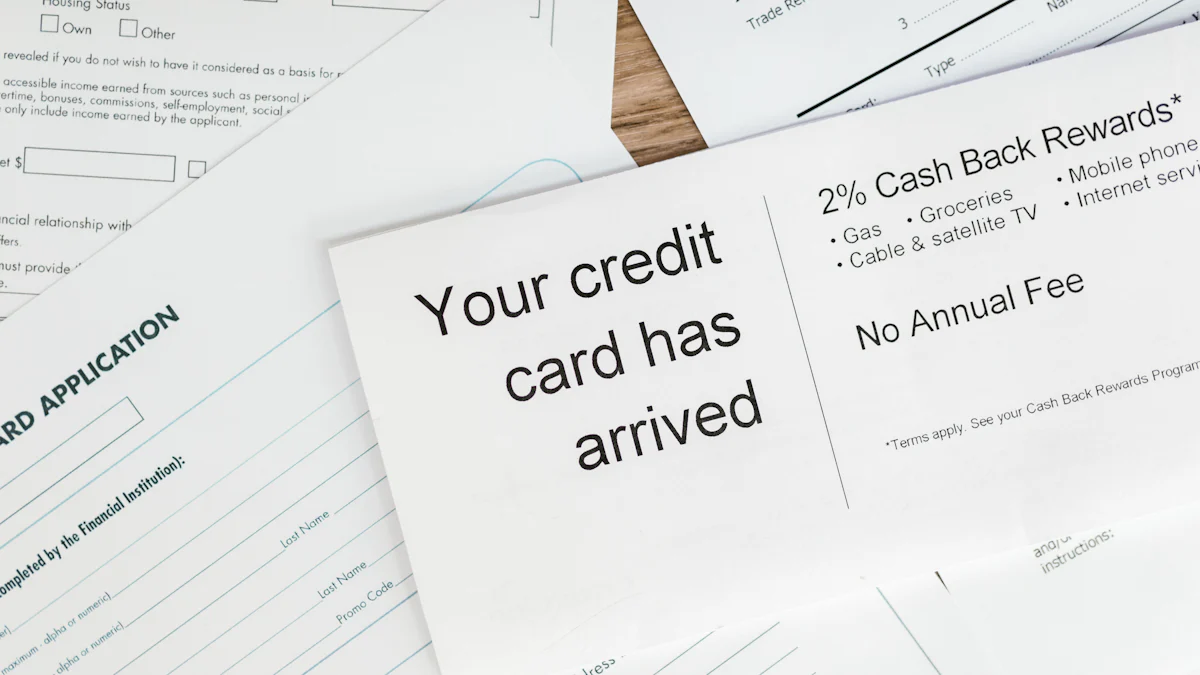Never Pay Fees for High-Limit Credit Cards

Never Pay Fees for High-Limit Credit Cards
Image Source: pexels
High-limit credit cards with no annual fees offer a smart way to manage finances. These cards provide access to higher credit limits without charging yearly fees, making them cost-effective. They also simplify earning rewards and often include perks like 0% APR on balance transfers.
| Benefit | Description |
|---|---|
| No fees | This card does not charge an annual fee |
| Simple rewards system | Offers an easy way to earn straightforward rewards |
| Attractive balance transfer rate | Offers a 0% introductory APR for 18 months on balance transfers |
These cards work well for large purchases and help maintain a low credit utilization ratio, which can boost your credit score. Credit cards with no annual fee and high limits combine flexibility and savings, making them a valuable tool for everyday spending and financial planning.
Key Takeaways
-
Credit cards with high limits and no fees save money.
-
These cards help with big buys and give spending freedom.
-
Keeping low balances on them can raise your credit score.
- Paying off the full amount each month avoids debt and fees.
What Are High-Limit Credit Cards?

Image Source: pexels
Definition of High-Limit Credit Cards
High-limit credit cards provide access to a larger credit line compared to standard cards. These cards are designed for individuals who need more spending power, whether for large purchases or managing multiple expenses. I’ve found that they’re especially useful for maintaining a low credit utilization ratio, which can positively impact your credit score. Unlike some premium cards, many high-limit options come with no annual fees, making them a cost-effective choice for everyday use.
How High-Limit Credit Cards Work
These cards function like any other credit card but with a higher spending limit. For example, while a standard card might offer a $5,000 limit, a high-limit card could provide $10,000 or more. This flexibility allows you to make significant purchases without maxing out your card. However, it’s important to use them responsibly. Spending more than you can repay can lead to debt and negatively affect your credit score.
Here’s a quick comparison of high-limit credit cards and standard cards:
| Pros | Cons |
|---|---|
| Higher credit limits allow for significant purchases without maxing out the card, enhancing spending flexibility. | The ability to spend more can lead to overspending and accumulating debt. |
| Often includes robust rewards programs for earning points, miles, or cash back. | Many high-limit cards have steep annual fees or additional charges for premium features. |
| Typically offers extensive perks, such as luxury travel benefits. | Carrying a balance can severely impact your credit score. |
Who Can Benefit from Credit Cards with No Annual Fee and High Limits
I believe these cards are ideal for anyone looking to save money while enjoying financial flexibility. If you frequently make large purchases or want to keep your credit utilization low, these cards can help. They’re also great for individuals who prefer not to pay annual fees but still want access to high credit limits. Whether you’re a frequent traveler, a small business owner, or someone managing household expenses, credit cards with no annual fee and high limits can simplify your financial life.
Benefits of Credit Cards with No Annual Fee and High Limits
Cost Savings from No Annual Fees
I always appreciate saving money where I can. Credit cards with no annual fee and high limits eliminate the need to pay yearly fees, which can range from $95 to $500 or more on premium cards. This means you can enjoy the benefits of a high-limit card without worrying about extra costs eating into your budget. Over time, these savings add up, especially if you use multiple cards. For me, this feature makes these cards a practical choice for everyday spending.
Access to High Credit Limits Without Extra Costs
High-limit credit cards provide access to larger credit lines, which can significantly impact your financial health. For example, a higher credit limit lowers your credit utilization ratio. Let me explain with a table:
| Credit Limit | Balance | Utilization Ratio |
|---|---|---|
| $2,000 | $1,000 | 50% |
| $5,000 | $1,000 | 20% |
| $10,000 | $1,000 | 10% |
As you can see, a higher limit reduces the percentage of your available credit used, which improves your credit score. These cards also enhance your credit mix, which accounts for 10% of your FICO score. I’ve found that this combination helps me maintain a strong credit profile without incurring extra fees.
Flexibility for Everyday and Large Purchases
I love the flexibility these cards offer. Whether I’m buying groceries or booking a vacation, the high credit limit ensures I don’t max out my card. This flexibility is especially useful for large purchases, like furniture or electronics, where spreading payments over time can ease financial strain. Additionally, credit cards with no annual fee and high limits allow me to manage my expenses without worrying about hidden costs. They simplify my financial planning and give me peace of mind.
How to Qualify for High-Limit Credit Cards
Credit Score Requirements
A good credit score opens the door to high-limit credit cards. From my experience, lenders typically look for scores in the Good to Excellent range (670-850). A higher score signals that you’re a responsible borrower, which increases your chances of approval. If your score falls below this range, you might still qualify, but the credit limit may be lower.
Here’s what I’ve learned about credit scores and eligibility:
-
A score of 670 or higher improves your chances of approval.
- A steady income paired with good credit strengthens your application.
If your score needs improvement, focus on paying bills on time and reducing existing debt. These steps can help you qualify for a high-limit card in the future.
Importance of Income and Debt-to-Income Ratio
Income plays a key role in determining your eligibility. Lenders often ask for income verification to calculate your credit limit. A higher income can lead to a higher limit, but it’s not the only factor. The debt-to-income ratio (DTI) is equally important.
A lower DTI shows better financial health. For example, if your DTI is above 43%, lenders may view you as a riskier borrower. This could result in stricter terms or even denial. I always recommend keeping your DTI low by managing debt effectively. This approach not only improves your chances of approval but also ensures better loan terms.
Building Good Financial Habits to Improve Eligibility
Good financial habits make a big difference. I’ve found that paying off balances in full each month and avoiding late payments can boost your credit score over time. Keeping your credit utilization below 30% also helps. For example, if your credit limit is $5,000, aim to use less than $1,500.
Some cards even reward responsible behavior. For instance, certain high-limit cards offer automatic credit limit increases after six on-time payments. This feature motivates me to stay consistent with my payments. By building these habits, you can improve your eligibility and enjoy the benefits of high-limit credit cards.
Top High-Limit Credit Cards with No Annual Fees

Image Source: unsplash
Chase Freedom Unlimited®: Features and Benefits
The Chase Freedom Unlimited® card offers a variety of perks that make it a standout choice. I appreciate how it combines cash back rewards with practical benefits for everyday use. Here’s a breakdown of its key features:
| Feature/Benefit | Description |
|---|---|
| Cash Back Rewards | Earn cash back on purchases with no minimum redemption requirement. |
| Purchase Protection | Covers eligible new purchases against damage or theft for 120 days, up to $500. |
| Travel Assistance | Provides legal and medical referrals while traveling away from home. |
| Auto Rental Coverage | Reimburses theft and collision damage for most rental vehicles. |
| 5% Cash Back on Lyft Rides | Earn 5% cash back on Lyft rides through March 31, 2025. |
| Zero Liability Protection | You won’t be held responsible for unauthorized charges. |
| Trip Cancellation Insurance | Reimbursement up to $1,500 per traveler for non-refundable fares. |
| DashPass Access | 6 months of complimentary DashPass for $0 delivery fees on eligible orders. |
This card also includes extended warranty protection and 24/7 fraud monitoring. I find these features especially useful for safeguarding purchases and ensuring peace of mind.
Petal® 2 ‘Cash Back, No Fees’ Visa® Credit Card: Features and Benefits
The Petal® 2 card stands out for its simplicity and transparency. I like how it eliminates common fees while still offering valuable rewards. Here’s what makes it unique:
-
No annual fee, late fee, or returned payment fee.
-
Cash back rewards on everyday purchases.
-
Reports to major credit bureaus, helping to build credit.
- No foreign transaction fees, making it ideal for international use.
This card is perfect for anyone looking to save money while building or improving their credit.
Citi Double Cash® Card: Features and Benefits
The Citi Double Cash® Card is one of my favorites for its straightforward rewards system. It offers 2% cash back on all purchases—1% when you buy and another 1% when you pay. Unlike other cards that focus on specific categories, this card keeps it simple. I also appreciate that it has no annual fee, making it a cost-effective option. With a recommended credit score range of 580-850, it’s accessible to many users.
Wells Fargo Active Cash® Card: Features and Benefits
The Wells Fargo Active Cash® Card provides unlimited 2% cash rewards on all purchases. I love how there are no limits or specific categories to track. Additional benefits include:
-
No annual fee.
-
A generous welcome bonus for new cardholders.
-
Cellphone protection and travel assistance services.
- Auto rental collision damage waiver and Visa Signature Concierge Services.
This card combines high rewards with practical perks, making it a versatile choice for everyday spending.
American Express Blue Cash Everyday® Card: Features and Benefits
The American Express Blue Cash Everyday® Card offers excellent rewards for everyday purchases. It provides cash back on groceries, gas, and online shopping. I find its no annual fee structure appealing, especially for a card with such targeted rewards. It’s a great option for families or anyone looking to maximize savings on routine expenses.
Tips for Using High-Limit Credit Cards Responsibly
Avoiding Overspending and Debt
High-limit credit cards can be a double-edged sword. While they offer financial flexibility, they also make it easy to overspend. I’ve learned that sticking to a few strategies helps me stay in control:
-
Spend only what you can afford to pay off immediately.
-
Create a budget to guide your spending and track expenses.
-
Avoid getting carried away by rewards or discounts.
- Limit your spending power by setting personal limits below your card’s maximum.
These steps keep me from falling into debt while still enjoying the benefits of a high-limit card. I always remind myself that the convenience of credit shouldn’t lead to financial strain.
Tip: Treat your credit card like cash. If you wouldn’t spend the money from your bank account, don’t charge it to your card.
Paying Off Balances in Full Each Month
Paying off my balance in full every month has been a game-changer. It helps me avoid interest charges, which can climb as high as 25% annually. By doing this, I save money and maintain a low credit utilization rate, which boosts my credit score. Carrying a balance, on the other hand, can lead to compounded interest and growing debt.
-
Paying in full avoids costly interest charges.
-
A low utilization rate (below 30%) reflects responsible credit use.
- Avoiding debt ensures financial stability over time.
This habit has made managing my finances much easier. I also feel more confident knowing I’m building a strong credit profile.
Monitoring Credit Utilization and Credit Score
I always keep an eye on my credit utilization ratio. This ratio compares how much credit I’m using to my total credit limit. A lower ratio, ideally under 30%, shows lenders that I’m managing my credit responsibly.
Maintaining a low utilization ratio has long-term benefits:
-
It helps me secure loans and credit cards with better terms.
-
A good credit score allows me to negotiate lower interest rates.
- Understanding this ratio helps me make smarter financial decisions.
I also monitor my credit score regularly. This helps me spot any errors or unusual activity early. By staying proactive, I ensure my credit remains in good standing and maximize the benefits of my high-limit credit cards.
Note: Many credit card issuers offer free credit score tracking. Use this feature to stay informed about your financial health.
High-limit credit cards with no annual fees offer incredible benefits. They save money by eliminating annual and foreign transaction fees. I’ve found they also help maintain low credit utilization, which boosts credit scores. Explore options that match your goals. Use these cards wisely to enjoy rewards, flexibility, and financial stability without debt.
FAQ
What is the best way to increase my credit limit?
I recommend contacting your card issuer after six months of responsible use. Paying on time and maintaining a low credit utilization ratio improves your chances.
Tip: Request a credit limit increase during a period of stable income for better approval odds.
Can I qualify for a high-limit credit card with fair credit?
Yes, but the limit may be lower. Focus on improving your credit score by paying bills on time and reducing debt before applying.
Note: Some cards, like the Petal® 2, cater to those building credit.
Do high-limit credit cards affect my credit score?
Yes, they can improve your score by lowering your credit utilization ratio. However, overspending or missing payments can harm your score.
Reminder: Always monitor your spending and pay balances in full to maintain a healthy score.